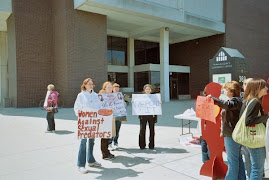Our view on social networking security: MySpace stalls on safety
Popular site could move faster to verify users’ age, identity.
A chilling story last week underscored how easily sexual predators can operate on MySpace, the most popular social networking site for younger teens. A New York couple allegedly posed on the site as a sexually inexperienced teen seeking advice. They're accused of enticing two underage girls for sex, including a strip club orgy.
This wasn't an isolated occurrence. MySpace, with more than 70 million users in the USA, has long had a reputation as a magnet for sexual predators. Around the nation, law enforcement officers have set up false MySpace identities to lure and capture dozens of them. Last year, the site, under threat of legal action, scoured its database for known sex offenders and closed at least 29,000 pages. This did not include predators who have not faced charges or those who use pseudonyms.
Given these threats, it no doubt came as a relief to parents and children last week when, after two years of talks, MySpace and attorneys general from every state but Texas signed an agreement that the site would take more steps to protect young people.
Many of the steps are commendable. Among them, MySpace will begin to put privacy settings on accounts for those who say they're younger than 18 (up from 16), run ads to advise parents on Internet safety and perhaps set up a registry for parents to bar their kids from joining (though any parent who believes that a 14-year-old can't create a new e-mail address and identity is naive).
MySpace already posts warnings that people might not be who they say they are. But a truly trustworthy firewall that can stop older people from posing as youngsters, and vice versa, requires stricter identity verification.
And therein lies the problem, as we discovered with a simple test that any parent can repeat. When we set up a MySpace page for a non-existent 15-year-old named Lisa, she was immediately exposed to ads to meet sexy singles and to the news, in an ad, that someone has a crush on her. She was asked to provide her cellphone number. A text message was received instantly after she complied.
We also found one 13-year-old who, like many of his friends, had gotten around privacy settings by claiming to be 22.
MySpace contends that adequate age verification software doesn't exist.
Several state attorneys general disagree, citing, for example, Aristotle software. So the two sides agreed to a classic tactic designed to give the appearance of action in the absence of it: a task force to study the matter.
Other social networking sites, such as Facebook, will be asked to join.
Even in the absence of a perfect software solution, interim steps are possible. How about using databases of drivers' licenses to cross-check ages? In more than 20 states, they are public records.
The point is, more effective safeguards are needed now, and not just against sexual predators, as another recent tragedy illustrates. A 13-year-old in Missouri, Megan Meier, hanged herself after an ex-friend's mother pretended to be a boy who befriended her, then sent her cruel messages.
MySpace declined to write an opposing view to this editorial. Had the site been confident in its protections, it probably would have been keen to trumpet them. More important, it would be moving faster to set up age and ID verifications, not just study them.
Hungry Wolves
-
This world really is sick and diluted with power hungry wolves who devour
any thing in their path.
As I look for the outcome of so many missing Childre...
2 years ago



No comments:
Post a Comment